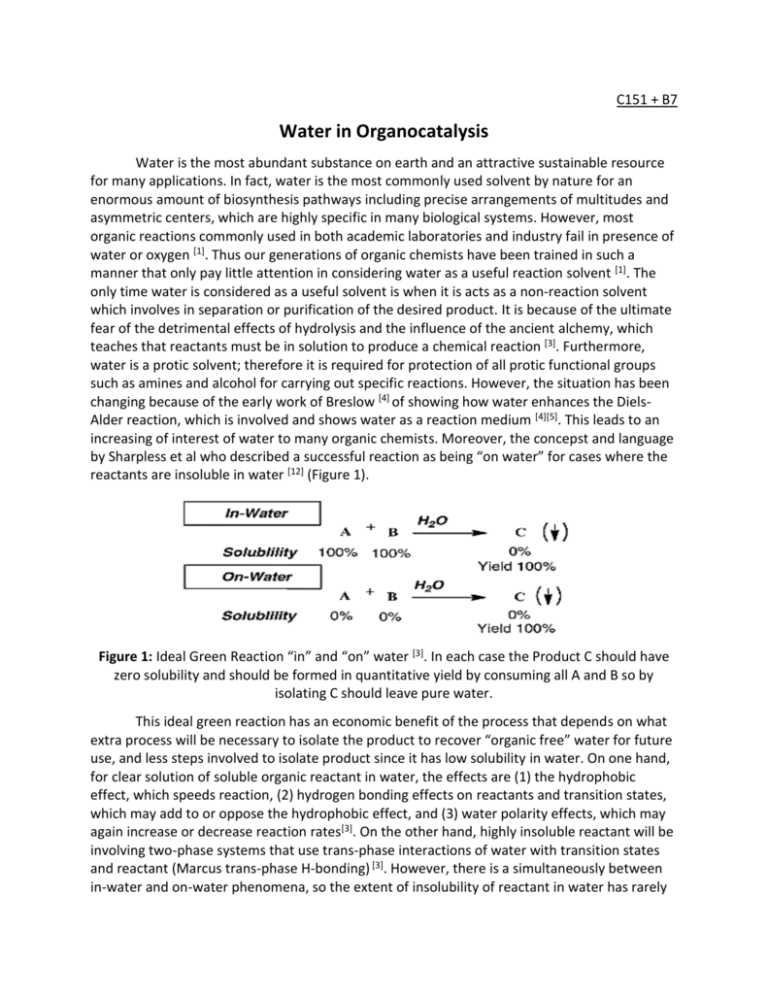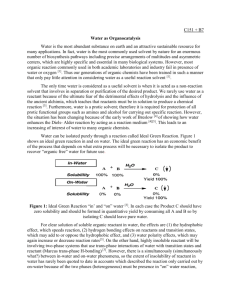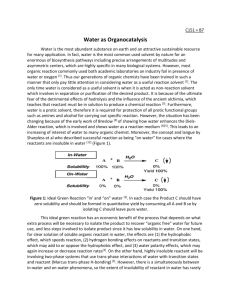solvents reactions
advertisement

C151 + B7 Water in Organocatalysis Water is the most abundant substance on earth and an attractive sustainable resource for many applications. In fact, water is the most commonly used solvent by nature for an enormous amount of biosynthesis pathways including precise arrangements of multitudes and asymmetric centers, which are highly specific in many biological systems. However, most organic reactions commonly used in both academic laboratories and industry fail in presence of water or oxygen [1]. Thus our generations of organic chemists have been trained in such a manner that only pay little attention in considering water as a useful reaction solvent [1]. The only time water is considered as a useful solvent is when it is acts as a non-reaction solvent which involves in separation or purification of the desired product. It is because of the ultimate fear of the detrimental effects of hydrolysis and the influence of the ancient alchemy, which teaches that reactants must be in solution to produce a chemical reaction [3]. Furthermore, water is a protic solvent; therefore it is required for protection of all protic functional groups such as amines and alcohol for carrying out specific reactions. However, the situation has been changing because of the early work of Breslow [4] of showing how water enhances the DielsAlder reaction, which is involved and shows water as a reaction medium [4][5]. This leads to an increasing of interest of water to many organic chemists. Moreover, the concepst and language by Sharpless et al who described a successful reaction as being “on water” for cases where the reactants are insoluble in water [12] (Figure 1). Figure 1: Ideal Green Reaction “in” and “on” water [3]. In each case the Product C should have zero solubility and should be formed in quantitative yield by consuming all A and B so by isolating C should leave pure water. This ideal green reaction has an economic benefit of the process that depends on what extra process will be necessary to isolate the product to recover “organic free” water for future use, and less steps involved to isolate product since it has low solubility in water. On one hand, for clear solution of soluble organic reactant in water, the effects are (1) the hydrophobic effect, which speeds reaction, (2) hydrogen bonding effects on reactants and transition states, which may add to or oppose the hydrophobic effect, and (3) water polarity effects, which may again increase or decrease reaction rates[3]. On the other hand, highly insoluble reactant will be involving two-phase systems that use trans-phase interactions of water with transition states and reactant (Marcus trans-phase H-bonding) [3]. However, there is a simultaneously between in-water and on-water phenomena, so the extent of insolubility of reactant in water has rarely been quoted to date in accounts which described the reaction only carried out by on-water because of the two phases (heterogeneous) must be presence in “on” water reaction, and the reaction rate of “on” water is driving and dependent on the solubility of reactant in water. “In” water effect on organic reactions The Breslow Hydrophobic Effect Hydrophobic effect is an effect in which the small covalent organic molecules repel water molecules. In biochemistry, there are many enzymes or proteins that have this phenomenon, which allow them to be folded in the right shape and be stable enough in the presence of water to carry out any catalytic reaction in our body. Small organic molecule acts the same way. When there is water present, they are forced to form aggregates in order to decrease the organic surface area exposed to water [13]. These aggregates cause a hydration shell that surround the organic molecules with H-bond links that run laterally along the hydrophobic surface. (Figure 2). In addition to large amounts of water present, the larger hydrophobic surface is required with some dangling hydrogen bonds groups that are orientated toward the barrier to maximize the packing density of the molecules (Figure 2) [14] [15] Figure 2: (i) the hydration shell in small hydrophobic aggregates (ii) large hydrophobic water interface. A and B is organic reactant which is usually insoluble in water. [3] Because the aggregates are held tightly together by hydrophobic interactions which allow these aggregates to process organic reactions, forced aggregates of organic reactants tends to rise in energy higher than aggregated ground states and bring it closer to the activated energy of transition state for the reactions. Engberts has shown that the reactive sites of these activated complexes lose their hydrophobic character entirely, a benefit that nature has conferred on water as reaction facilitator [16] [17]. Hence, water acts a catalyst that reduces the activation energy and significantly enhances rate of reactions. Estimates of lowering the activation energy of Diels-Alder reactions (as mentioned earlier) by hydrophobic effect show a direct agreement with observed rate increases [18][19]. Diels-Alder cycloaddition is a powerful synthetic transformation that has been used widely by organic chemists, and solvent effect of reactions was studied in early 1939 when Hopff and Rautenstrauch disclosed that Diels-Alder reactions could be carried out effectively in an “aqueous dispersion” rather than their parent reaction which were carried out in presence of dispersing or emulsifying agents. [20]. Later in 1980, Rideout and Breslow reported that both rate enhancement and excellent selectivity could be achieved for certain Diels-Alder reactions when the reactions are carried out in diluted aqueous solution [21]. Figure 3, and table 1 and 2 show the rate constant and selectivity of the product for Diels-Alder reactions in addition of water compared to other solvents. Breslow later then hypothesized the Breslow hydrophobic effect as mentioned. Figure 3: Diels-Alder reaction [1] Table 1: The rate constant of reactions in Figure 3 with different solvents [1] Table 2: The rate constant of reactions in Figure 3 with different solvents [1] The hydrophobic effect has a major influence on stereo chemical outcomes of reaction, and it often favors product with more compact transition states and normal preference for endocyclo-addition in Diels-alder and Huisgen cyclo-addition which both tend to be increased for reactions in water [22][23][24][25]. Hydrogen-bonding effect In addition to hydrophobic effects, when organic reactions possess a hydrogen bond acceptor site, the water molecules will form H-bonds with them. The hydrogen boding shows a negative and a positive effect in the presence of water by decreasing or increasing the LUMO and HOMO gap in the reaction. The transition state of covalent reaction can be viewed in terms of frontier orbital interaction involving the HOMO and LUMO pairs of each molecules A and B for reaction A+B = C shown in Figure 4[3]. H-bonding is like an electron-withdrawing substituent, which lower the energy of frontier orbitals by reducing electron density and interorbital repulsion on the substrate (reactant) that contain H-acceptor from H-bonding from water and activate it to make it become more reactive toward other substrates. Thus the effect of water depends on the presence or absence of H-bonding interaction with reactants. The simplest case is where a reactant has no H-bond acceptor site. In figure 4, the reaction involving 4π HOMO control in reactant A H-bonding to B will speed the reaction by lowering the HOMOLUMO gap and the transition state, and the reverse control reaction in 4π LUMO in A with Hbonding at B increasing the frontier gap. Thus, when both reactants contain a H-bond acceptor site, the effect of water H-bonding on the rate will depend on relative lowering of the dominant frontier to increase or decrease the gap on transition state energy[3]. Hence, water can have both negative and positive effects on a subtracted as expected. Although H-bonding does not have as high of an impact as the hydrophobic effect, it still plays an important role in predicting the rate of reaction. Figure 4: Frontier orbitals energies of cycloaddition reactions. [3] Polarity Effect Polarity has a small impact in water as organocatalysis. Water is a highly polar solvent, which is why it has been used as a solvent for extraction of non-polar organic compounds. Hence, according to thermodynamics, rate of reactions with transition states more polar then initial states will increase in water and decrease when the transition states are less polar than initial states [26][27]. On water On water reaction. Marcus trans-Phase H-bonding. An important conceptual difference between “in” and “on” water is in the phase of reaction. “In” water reaction involves with homogenous condition, and “on” water reaction involves with heterogeneous condition of insoluble reactant in water. Most of “on” water reaction concept might have some overlapped and build from theoretical concept of “in” reaction such as hydrophobic effect of water and H-Bonding, which are the main driving forces of “in” water catalysis. In 2007, Marcus and Jung proposed that the key to understanding the on-water phenomenon was the unique chemistry that occurs at the water-oil (heterogeneous) phase boundary [3] (Figure 1). Similarly with hydrophobic effect, but at the heterogeneous phase, the large hydrophobic surface about 1 in 4 of water molecules in the final layers has an OH free group that is directed at the boundary in contrast to small hydrophobic aggregates which can be fully enclosed by hydration water cluster with lateral H-bonds along the boundary [14-16,28-30].The impact of catalysis depend on the activation energy of H-bonding from water that activate the substrate to decrease the activation energy of reaction. The catalytic effect of Marcus provides a remarkable insight to the “on” water phenomenon. Thus the concept of both “in” and “on” water catalysis allow a new door to many green organic reactions in a future. Table 3: Summary table of “in” and on “water” boundaries for water insoluble reactants [3] Reference: 1) 2) 3) 4) 5) 6) 7) 8) 9) 10) 11) 12) 13) 14) 15) 16) 17) 18) 19) 20) 21) 22) 23) 24) 25) 26) 27) 28) 29) 30) Chanda, A. and V. V. Fokin (2009). "Organic Synthesis “On Water”." Chem Rev 109(2): 725-748. Ball, P. H 2 O: A Biography of Water; Phoenix Press: London, 2000. Butler, R. N. and A. G. Coyne (2010). "Water: Nature’s Reaction Enforcer—Comparative Effects for Organic Synthesis “In-Water” and “On-Water”." Chem Rev 110(10): 63026337. Rideout, D. C.; Breslow, R. J. Am. Chem. Soc. 1980, 102, 7816–7817. Diels, O.; Alder, K. Justus Liebigs Ann. Chem. 1931, 490, 243–257. Head-Gordon, T.; Hura, G. Chem. Re V . 2002, 102. Bellissent-Funnel, M. C.; Done, J. C. Hydrogen Bond Networks; Kluwer Academic Publications: Boston, MA, 1994. Moore, F. G.; Richmond, G. L. Acc. Chem. Res. 2008, 41, 739 Shen, Y. R.; Ostroverkhov, V. Chem. Re V . 2006, 106, 1140. Li, C.-J.; Chan, T.-H. Organic reactions in aqueous media; Wiley: New York, 1997. Organic Synthesis in Water; Grieco, P. A., Ed.; Blackie: London,1998. Narayan, S.; Muldoon, J.; Finn, M. G.; Fokin, V. V.; Kolb, H. C.; Sharpless, K. B. Angew. Chem., Int. Ed. 2005, 44, 3275–3279. Breslow, R. Acc. Chem. Res. 1991, 24, 159–164. Lee, C. Y.; McCammon, J. A.; Rossky, P. J. J. Chem. Phys. 1984, 80, 4448–4455. Scatena, L. F.; Brown, M. G.; Richmond, G. L. Science 2001, 292,908–912. Otto, S.; Engberts, J. B. F. N. Org. Biomol. Chem. 2003, 1, 2809–2820. Meijer, A.; Otto, S.; Engberts, J. B. F. N. J. Org. Chem. 1998, 63, 8989–8994. Blake, J. F.; Jorgensen, W. L. J. Am. Chem. Soc. 1991, 113, 7430–7432. Chandrasekhar, J.; Shariffskul, S.; Jorgensen, W. L. J. Phys. Chem.B 2002, 106, 8078– 8085. Hopff, H.; Rautenstrauch, C. W. U.S. Patent 2,262,002, 1939. Rideout, D. C.; Breslow, R. J. Am. Chem. Soc. 1980, 102, 7816. Garner, P. P. Organic Synthesis in Water; Grieco, P. A., Ed.; Blackie Academic and Professional: London, 1998; pp 1 - 41. Butler, R. N.; Cunningham, W. J.; Coyne, A. G.; Burke, L. A. J. Am.Chem. Soc. 2004, 126, 11923–11929. Breslow, R.; Maitra, U. Tetrahedron Lett. 1984, 25, 1239–1240. Breslow, R.; Maitra, U.; Rideout, D. C. Tetrahedron Lett. 1983, 24,1901–1904. Reichardt, C. Sol V ents and Sol V ent Effects in Organic Chemistry,3rd ed.; Wiley-VCH: Weinheim, Germany, 2003. Gajewski, J. J. J. Org. Chem. 1992, 57, 5500–5506. Bakulin, A. A.; Liang, C.; Jansen, T. L. C.; Wiersma, D. A.; Bakker,H. J.; Pshenichnikov, M. S. Acc. Chem. Res. 2009, 42, 1229–1238. Shen, Y. R.; Ostroverkhov, V. Chem. Re V . 2006, 106, 1140–1154. Du, Q.; Freysz, E.; Shen, Y. R. Science 1994, 264, 826–828







![Cooper_Abstract_MOF_2014[1]](http://s3.studylib.net/store/data/006662442_1-973d7b3fb19ef7da02e38c87851e45c2-300x300.png)